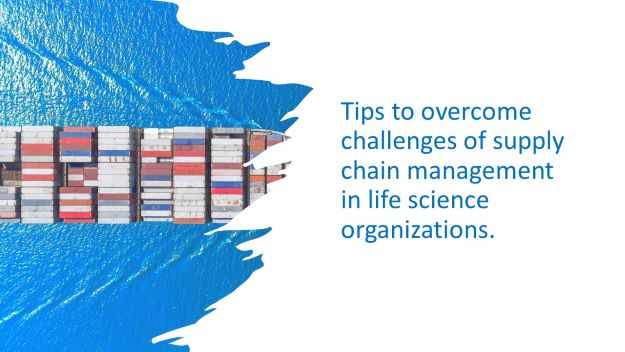It's true that life science companies have been addressing supply chain issues since the break of coronavirus pandemic further aggravated by port closures in several parts of the world. However, most companies are fire-fighting the issue thus bleeding their bottom line severely. Therefore I say, that, there is a dire need for supply chain process re-engineering in life science organizations. But then, how to go about it?
In this post, I shall touch upon ways to overcome challenges of supply chain management within the life science sector.
Life sciences supply chains are a unique ecosystem, filled with complex regulatory requirements, varying geographical landscapes, and multiple stakeholders. These factors can lead to significant challenges for organizations. These headwinds can lead to high lead times, high production cost, wastages, delays in product launch, increased remediation costs etc. As a result, enterprises must establish safeguards and shore-up their delicately balanced supply chains to avoid such pitfalls. Furthermore, include supply chain related factors in your QBD protocol while developing the products.
In addition to regulatory requirements, life sciences companies face significant risk when it comes to transportation. For example, delays or damaged shipments may result in thousands of dollars in labor costs. In addition, damaged goods must be disposed off according to legal requirements. As a result, life sciences companies need to be more efficient in addressing these risks. Digital tools and analytics are helpful in overcoming such challenges.
Digital tools and analytics help companies better predict customer demand, analyze supply chain complexities, and link automated production units to real-time demand. These tools and technologies also improve the transparency of the supply chain, which can boost trust and reduce cost-to-serve. Further, emerging technologies such as innovative Enterprise Resource Management (ERM) solutions can also help address such challenges.
A global shortage of talent in supply chain management with expertise in life sciences, is another challenge for life sciences organizations. According to a recently published survey, firms in the life sciences sector are worried about their ability to find the right talent to fill their positions. With labor costs rising, the competition for skilled professionals is fierce. Dedicated teams who could handle the organization’s supply chain led by an operational excellence expert is thus the need of the hour.
Additionally, shipping life science products is often a delicate process. Although drug-products are developed complying to the ICH norms of stability, a delay or deviation in the supply chain can lead to product expiration or render the entire shipment useless.
In addition to delivering products on-time, companies must balance consumer demand with the safety of their products. Sometimes, even the slightest change in temperature can ruin a product. Real-time tracking helps companies and logistics providers react quickly to potential delays. It also gives them a 360-degrees view of the entire supply chain, allowing them to respond before problems occur.
In addition to ensuring the safety and quality of life science products, companies must also meet regulatory standards. The life sciences industry is one among the most regulated industries in the world, and regulatory requirements vary widely from country to country. It is imperative for life sciences firms to follow international guidelines and standards. Many of these regulations are complex, and non-compliance with these regulations can result in stiff financial penalties, brand damage, and even litigation.
Another challenge in life sciences supply chain management is finding the right logistics provider. The selection process is not simple and often involves numerous variables and factors. It is imperative to choose the right delivery partner. If something goes wrong, the right supplier can help the business bounce back. In the life sciences industry, overcoming challenges and finding the right logistics provider is vital. Hence, business processes underlying vendor selection must be reset regularly.
Yet another parameter of improving supply chain is use of artificial intelligence (AI) in transforming mobility. Fully automated driving vehicles equipped with self-learning navigation systems are expected to boost supply chain logistics efficiency to the summit.
Logistics industry presently, still relies on human involvement to varying degrees; perhaps because our human race is diligent and wants to solve all problems ourselves. But the times are changing …
We have passed thru the steam age and the electronics age, are in the current information age, but the future shall be the age of artificial intelligence.
You may say we are using smartphones or have robots doing the cleaning or handling warehouses or machines with CIP (clean-in-place) automation or even robots leading businesses as a CEO. But it is only the tip of the iceberg. In the future, AI technology will come alongside with us and change the world.
So, what world will be the next world we live in?
My answer is- Drug delivery techniques are already undergoing a profound change. Combined with fully automated logistics in the life sciences sector, we'll welcome a brand-new world …
Related reading:
- Kaizen for pharmaceutical, medical device and biotech industries
- How to cut costs strategically using Kaizen
- Streamline processes and workflows with Gemba Walk.
- Top Ten Strategic Decision-Making Tools for Operational Excellence
- Continuous Improvement for Drug Industry: Part 1: Introduction to Digitalization in Pharmaceutical and Medical Device R&D.
#businessprocessimprovement #continuousimprovement #supplychainmanagementinlifesciencessector #logistics
#digitalization #digitalizationinpharmaceuticalindustry #pharmasourcing #autonomousvehicles #automateddrivingtechnology #selflearningnavigationsystem





















